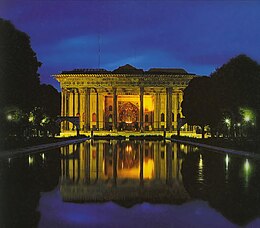

| UNESCO World Heritage Site | |
|---|---|
 | |
| Location | Isfahan, Isfahan Province, Iran |
| Part of | The Persian Garden |
| Criteria | Cultural: (i)(ii)(iii)(iv)(vi) |
| Reference | 1372-003 |
| Inscription | 2011 (35th Session) |
| Area | 5.8 ha (620,000 sq ft) |
| Buffer zone | 28.92 ha (3,113,000 sq ft) |
| Coordinates | 32°39′27″N 51°40′20″E / 32.65750°N 51.67222°E / 32.65750; 51.67222 |
|
Location of Chehel Sotoun in Iran | |
Chehel Sotoun (Persian: چهلستون, lit. 'Forty Columns') is a Persian pavilion in the middle of a park at the far end of a long pool, in Isfahan, Iran, built by Shah Abbas II to be used for his entertainment and receptions. In this palace, Shah Abbas II and his successors would receive dignitaries and ambassadors, either on the terrace or in one of the stately reception halls.
The name, meaning "Forty Columns" in Persian, was inspired by the twenty slender wooden columns supporting the entrance pavilion, which, when reflected in the waters of the fountain, is said to appear to be forty.[1]
As with the Ali Qapu, the palace contains many frescoes and paintings on ceramic. Many of the ceramic panels have been dispersed and are now in the possession of major museums in the West. They depict specific historical scenes such as the infamous Battle of Chaldiran against the Ottoman Sultan Selim I, the reception of an Uzbek king in 1646, when the palace had just been completed, the welcoming of the Mughal Emperor Humayun who took refuge in Iran in 1544, and the battle of Taher-Abad in 1510 where the Safavid Shah Ismail I vanquished and killed the Uzbek king. A more recent painting depicts Nader Shah's victory against the Indian Army at Karnal in 1739. There are also less historical, butmore aesthetic compositions in the traditional miniature style, themed around life, love, and joy.[2]
The Chehel Sotoun Palace is among the 9 Iranian gardens which are collectively registered as one of Iran's 23 registered World Heritage Sites under the name of the Persian Gardens.[3]
In the pavilion, the combined designs of the walls and ceiling of the hall, which are placed in Lachak Toranj (corner and medallion), and the main lines of the building divisions, which are a combination of painting, tiling and other various decorations, make the building one of the best examples of Persian architecture during the Safavid era. At present, the mansion operates as a museum; and its central hall displays some works of art from different periods of Iran.[4]
{{cite web}}: Missing or empty |title= (help)
| International |
|
|---|---|
| National |
|